

Over the past fifteen years these documents, brought together with other miscellaneous manuscripts, have been dated, collated, transcribed, translated where necessary, and published online with editorial commentary. Through their good offices the manuscripts were lodged in libraries in Cambridge and Jerusalem. Belatedly, two individuals-the economist John Maynard Keynes and biblical scholar, philologist, and collector, Abraham Yahuda-realised the value of this material and ensured that it was not completely dispersed among private collectors.

They attracted little interest, and no institutional bidders sought to acquire them. The bulk of the alchemical and theological writings, however, did not make a public appearance until 1936 when, for financial reasons, their owner put them up for auction at Sotheby’s. Newton’s scientific papers eventually found their way into the Cambridge University Library in the late nineteenth century. Accordingly, they were disinclined to see his heterodox views made public. The first custodians of his literary estate, Newton’s half-niece and housekeeper Catherine, and her husband John Conduitt, who succeeded Newton as Master of the Mint, were understandably concerned to preserve Newton’s reputation, not just as a man of science, but as an exemplary Christian. Public knowledge of his private beliefs would have had catastrophic consequences for his career. Newton had been careful to conceal his position from his contemporaries, and with good reason. On the basis of his methodical biblical and historical researches he had arrived at the view that the doctrine of the Trinity was a corruption of true Christianity. Newton was never able to reconcile himself to the idea that Christ was truly divine and part of the triune godhead. On the other side, those who wished to perpetuate the image of Newton as a godly scientist had to reckon with the fact that his unpublished writings exhibited unmistakable evidence of deeply heretical views. Subsequently, his religious views (or at least what was known of them) came to be regarded as an embarrassment or, at best, irrelevant to his reputation and achievements.

Newton’s deep personal piety and preoccupation with matters of biblical chronology and prophecy, had they become widely known, would have challenged Enlightenment assumptions about a necessary opposition between religion and science. In the eighteenth century Newton had become an icon of Enlightenment philosophes and his scientific achievements were regarded by them as emblematic of scientific rationality. ” In a sense, this adverse finding was repeatedly rendered on Newton’s unpublished theological writings, virtually to the end of the twentieth century.Ī number of factors conspired against the publication of Newton’s private theological writings. A number of the manuscripts still bear his scribbled verdict: “not fit to be printed. After Newton died intestate, Thomas Pellet was charged by the Royal Society with assisting his executors in determining what material should be published. That Newton’s theological writings have now seen the light of day at all is a story in its own right. It is a remarkable work of painstaking scholarship, engagingly written, and packed with new insights into the man and his milieu. This meaty volume represents the first fruits of these assiduous editorial endeavors and it presents what is surely the definitive account of Newton’s religious world view. But Priest of Nature gives us cause to be doubly grateful. For this alone we owe him and his fellow researchers an enormous debt of gratitude. For almost twenty years he has led the team behind “The Newton Project, ” a visionary enterprise devoted to the online publication of the complete corpus of Isaac Newton’s papers. Rob Iliffe, who holds the chair in History of Science at the University of Oxford, has an unmatched mastery of this manuscript material. But the vast bulk of this material, well over two million words, was devoted to religious themes-chronology, prophecy, the apocalypse, and the history of early religion and of the Christian church. Along with the expected jottings on scientific and mathematical topics was a surprising number of items devoted to alchemy. Almost 2000 short manuscripts, haphazardly housed in numerous boxes, bore testimony to the extraordinary range of Newton’s interests. When Isaac Newton died on March 31, 1727, his estate included a massive amount of unpublished material. Rob Iliffe, Priest of Nature: The Religious Worlds of Isaac Newton (Oxford: Oxford University Press, 2017), pp. Peter Harrison reviews Rob Iliffe’s Priest of Nature The Religious Worlds of Isaac Newton.


 0 kommentar(er)
0 kommentar(er)
